Greenway exhibit targets urban landscapes in New Jersey for preservation
-
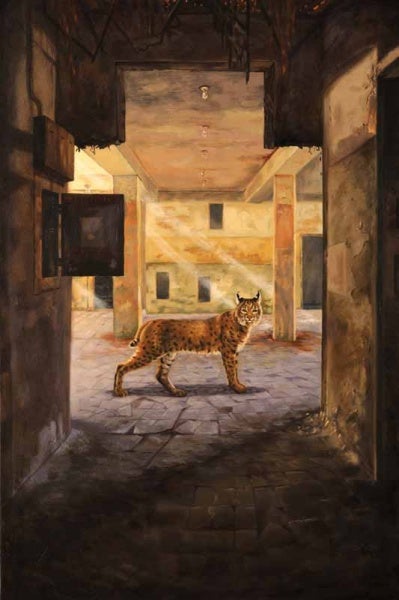
<p><span style="color: #222222; font-family: arial, sans-serif; font-size: 16px;">Abandoned by </span>Tricia Zimic</p> <p><span style="color: #222222; font-family: arial, sans-serif; font-size: 16px;"></span></p>
-
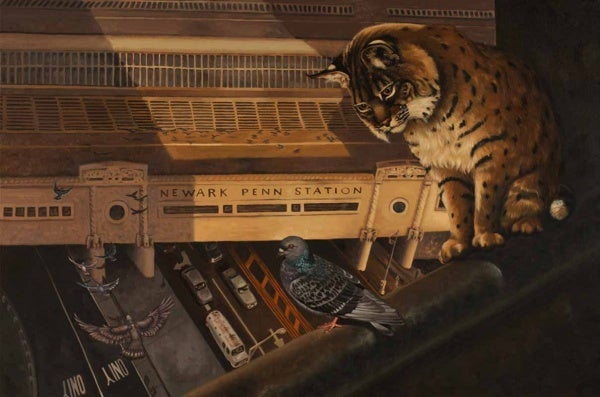
<p><span style="color: #222222; font-family: arial, sans-serif; font-size: 16px;">Fast Food by </span>Tricia Zimic</p> <p><span style="color: #222222; font-family: arial, sans-serif; font-size: 16px;"></span></p>
-
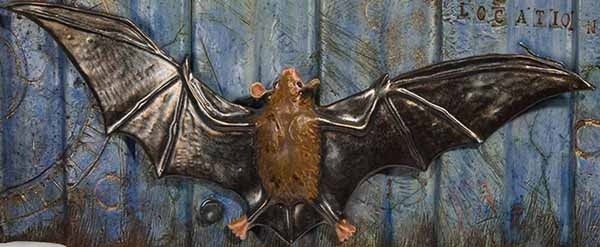
<p><span style="color: #222222; font-family: arial, sans-serif; font-size: 16px;">Cope II by </span>Tricia Zimic</p> <p><span style="color: #222222; font-family: arial, sans-serif; font-size: 16px;"></span></p>
-
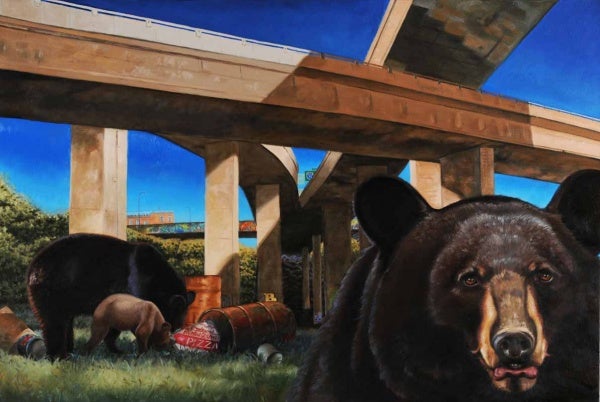
<p><span style="color: #222222; font-family: arial, sans-serif; font-size: 16px;">Lost-N-Found</span> by Tricia Zimic</p>
-
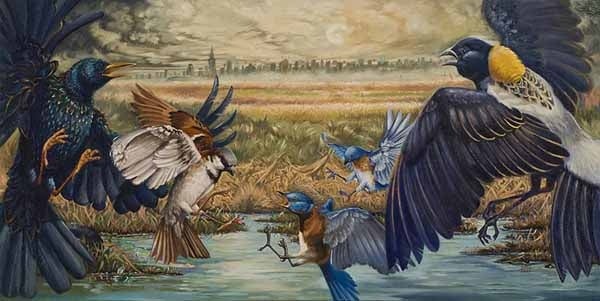
<p><span style="color: #222222; font-family: arial, sans-serif; font-size: 16px;">Fight or Flight by </span>Tricia Zimic</p> <p><span style="color: #222222; font-family: arial, sans-serif; font-size: 16px;"></span></p>
-
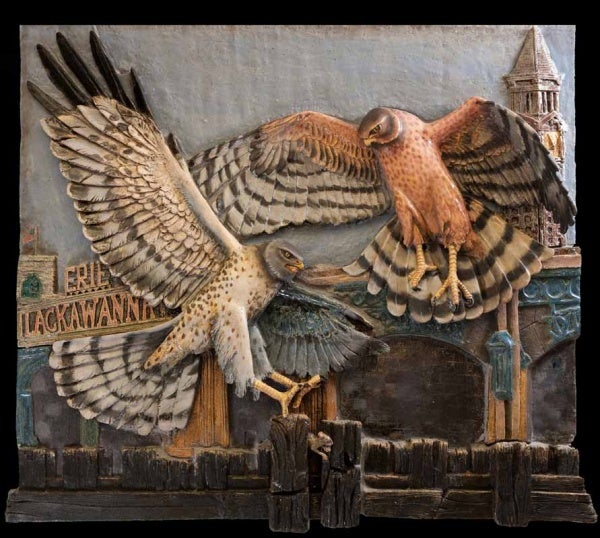
<p class="p1"><span style="color: #222222; font-family: arial, sans-serif; font-size: 16px;">Pier Pressure</span> by Tricia Zimic</p>
This is part of a series from Ilene Dube of The Artful Blogger.
Under the graffiti-covered columns elevating I-95 in New Jersey – aka the New Jersey Turnpike – black bears and a cub are scrounging a meal alongside rusted oil barrels. A delectable find awaits: a large white pizza box from Maplewood Roman Gourmet.
In both paintings and ceramic reliefs, Tricia Zimic highlights quintessential urban landscapes of our time, showing how animals co-exist with New Jersey highways, cities and transportation hubs.
On view at D&R Greenway’s Johnson Education Center in Princeton through February 15, Urban Landscapes “evokes the contemporary relationship between the urban and the natural,” says Curator Diana Moore. In work from 10 artists, “constellations compete with city lights, and cement clover leafs are more common than wildflowers.”
Works in which nature intrudes upon the city is paired with work in which the city intrudes upon nature.
Black bears, like those in Zimic’s painting, are listed as “least concern” status, according to New Jersey Department of Environmental Division of Fish and Wildlife. The bears’ diet includes grasses, roots, berries, fish… and pizza. The animal is highly adaptable, now that fast foods are readily available in the Meadowlands.
Zimic has worked as a re-forester and seen the devastation that happens when nature goes awry. “I have seen animals trying to survive in the most unlikely places: birds nesting in high tension towers, salamanders making homes in beer cans, and bears, coyotes and bobcats, all victims of urban sprawl, roaming in urban yards.”
In “Fast Food,” a wild bobcat and hunting pigeon are perched on a building ledge overlooking the McKim, Mead and White-designed Newark Penn Station. With its natural swamps and riverfront, “the area around Penn Station was once fertile hunting ground,” says Zimic.
The Maplewood resident has painted a bobcat in a stone-paved corridor of the ruins of the Greystone Park Psychiatric Hospital in Morristown, a relic with crumbling walls. The bobcat is lit by a few rays of sunshine, as if it is poised to make a comeback, now that humans have failed to keep up the environment they built.
In “Fight or Flight,” starlings and house sparrows appear to be fighting each other over a Meadowlands swamp, with a hazy view of the Secaucus skyline in the distance. It is a beautiful painting, in the style of Audubon, but telling a modern day horror story. The invasive starling, brought to New York for a Shakespeare Festival in the 19th century, has adapted well and ousted indigenous birds to become the most populous bird in North America. Also duking it out for food in this painting are the endangered bobolink and bluebird.
In New Jersey, three-quarters of the land is taken up with urban sprawl, says Zimic, whose work was exhibited at the New Jersey State Museum last year. “There is only one-quarter left for plants and animals. So I want to show where the plants and animals end up.
But it’s not all doom and gloom for the urban environment. Linnea W. Rhodes shows us streetscapes of some of the state’s charming towns – Westfield, Cranford and Summit, with tree-lined streets, federal style architecture, plazas, steeples and a clock tower. Jean Childs Buzgo sets the “Nighthawks” of Edward Hopper’s iconic painting in a contemporary coffee bar. Buzgo shows us the Lambertville Bridge at dusk with pink clouds and lights reflecting in the Delaware – beauty is alive and well in the urban landscape.
Thom Lynch is nostalgic for the places of his youth. His paintings immortalize old shops, replaced by chain stores: an old ice cream sign fading on white-washed brick, a garage with the classic red-on-white lettering for “Standard Esso Dealer,” White Diamond Hamburgers seen through the windshield of a car. “The businesses have all gone,” writes Lynch. “Still I can’t go by the old locations without seeing them there. I think of them as my ghosts.” Since Lynch painted them, the signs have been painted over and the clocktower is gone. His painting “Houses on Cherry Land” is row upon row of the same developer-style house.
Frankie Mack, one of the A-Team artists – a group of self-taught artists who regularly use the services of the Trenton Area Soup Kitchen and formed an artist cooperative — paints a wild cityscape splashed with colorful paint, and a still life of abstracted instruments that evokes jazz, the music of urban land.
In “State and Broad, Winter,” Louis Russomanno, who has won numerous awards at Prallsville Mill, shows us cars trudging through wet snow, a stopped bus and pedestrians in heavy winter coats, heads hung low, surrounded by the federal style architecture of our capital city. On a clear day, we might be more aware of the cheesy storefronts, but in this snowy haze nature reclaims the man-made.
The urban landscape theme was selected to demonstrate the importance of land preservation to all communities. D&R Greenway has helped with preservation and landscape restoration projects at Cadwalader Park in Trenton and locations in Bordentown. “Even a piece of open space the size of a single lot connects people to the land,” says Greenway CEO & President Linda Mead. A portion of the sale of the artwork supports the preservation and stewardship mission of the land trust.
————-
The Artful Blogger is written by Ilene Dube and offers a look inside the art world of the greater Princeton area. Ilene Dube is an award-winning arts writer and editor, as well as an artist, curator and activist for the arts.
WHYY is your source for fact-based, in-depth journalism and information. As a nonprofit organization, we rely on financial support from readers like you. Please give today.




